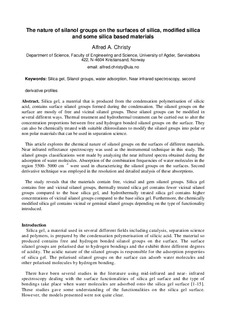| dc.description.abstract | Silica gel, a material that is produced from the condensation polymerisation of silicic acid, contains surface silanol groups formed during the condensation. The silanol groups on the surface are mostly of free and vicinal silanol groups. These silanol groups can be modified in several different ways. Thermal treatment and hydrothermal treatment can be carried out to alter the concentration proportions between free and hydrogen bonded silanol groups on the surface. They can also be chemically treated with suitable chlorosilanes to modify the silanol groups into polar or non polar materials that can be used in separation science.This article explores the chemical nature of silanol groups on the surfaces of different materials. Near infrared reflectance spectroscopy was used as the instrumental technique in this study. The silanol groups classifications were made by analyzing the near infrared spectra obtained during the adsorption of water molecules. Absorption of the combination frequencies of water molecules in the region 5500- 5000 cm -1 were used in characterizing the silanol groups on the surfaces. Second derivative technique was employed in the resolution and detailed analysis of these absorptions.The study reveals that the materials contain free, vicinal and gem silanol groups. Silica gel contains free and vicinal silanol groups, thermally treated silica gel contains fewer vicinal silanol groups compared to the base silica gel, and hydrothermally treated silica gel contains higher concentrations of vicinal silanol groups compared to the base silica gel. Furthermore, the chemically modified silica gel contains vicinal or geminal silanol groups depending on the type of functionality introduced. | nb_NO |
